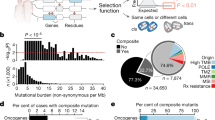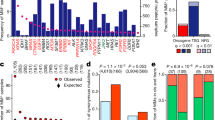Abstract
Understanding the molecular underpinnings of cancer is of critical importance to the development of targeted intervention strategies. Identification of such targets, however, is notoriously difficult and unpredictable. Malignant cell transformation requires the cooperation of a few oncogenic mutations that cause substantial reorganization of many cell features1 and induce complex changes in gene expression patterns2,3,4,5,6. Genes critical to this multifaceted cellular phenotype have therefore only been identified after signalling pathway analysis7,8,9,10 or on an ad hoc basis4,11,12,13,14. Our observations that cell transformation by cooperating oncogenic lesions depends on synergistic modulation of downstream signalling circuitry15,16,17 suggest that malignant transformation is a highly cooperative process, involving synergy at multiple levels of regulation, including gene expression. Here we show that a large proportion of genes controlled synergistically by loss-of-function p53 and Ras activation are critical to the malignant state of murine and human colon cells. Notably, 14 out of 24 ‘cooperation response genes’ were found to contribute to tumour formation in gene perturbation experiments. In contrast, only 1 in 14 perturbations of the genes responding in a non-synergistic manner had a similar effect. Synergistic control of gene expression by oncogenic mutations thus emerges as an underlying key to malignancy, and provides an attractive rationale for identifying intervention targets in gene networks downstream of oncogenic gain- and loss-of-function mutations.
This is a preview of subscription content, access via your institution
Access options
Subscribe to this journal
Receive 51 print issues and online access
$199.00 per year
only $3.90 per issue
Buy this article
- Purchase on Springer Link
- Instant access to full article PDF
Prices may be subject to local taxes which are calculated during checkout




Similar content being viewed by others
References
Hanahan, D. & Weinberg, R. A. The hallmarks of cancer. Cell 100, 57–70 (2000)
Yu, J. et al. Identification and classification of p53-regulated genes. Proc. Natl Acad. Sci. USA 96, 14517–14522 (1999)
Zhao, R. et al. Analysis of p53-regulated gene expression patterns using oligonucleotide arrays. Genes Dev. 14, 981–993 (2000)
Schulze, A., Lehmann, K., Jefferies, H. B., McMahon, M. & Downward, J. Analysis of the transcriptional program induced by Raf in epithelial cells. Genes Dev. 15, 981–994 (2001)
Huang, E. et al. Gene expression phenotypic models that predict the activity of oncogenic pathways. Nature Genet. 34, 226–230 (2003)
Boiko, A. D. et al. A systematic search for downstream mediators of tumor suppressor function of p53 reveals a major role of BTG2 in suppression of Ras-induced transformation. Genes Dev. 20, 236–252 (2006)
Vogelstein, B., Lane, D. & Levine, A. J. Surfing the p53 network. Nature 408, 307–310 (2000)
Vousden, K. H. & Lu, X. Live or let die: the cell’s response to p53. Nature Rev. Cancer 2, 594–604 (2002)
Downward, J. Targeting RAS signalling pathways in cancer therapy. Nature Rev. Cancer 3, 11–22 (2003)
Rodriguez-Viciana, P. et al. Cancer targets in the Ras pathway. Cold Spring Harb. Symp. Quant. Biol. 70, 461–467 (2005)
Okada, F. et al. Impact of oncogenes in tumor angiogenesis: mutant K-ras up-regulation of vascular endothelial growth factor/vascular permeability factor is necessary, but not sufficient for tumorigenicity of human colorectal carcinoma cells. Proc. Natl Acad. Sci. USA 95, 3609–3614 (1998)
Clark, E. A., Golub, T. R., Lander, E. S. & Hynes, R. O. Genomic analysis of metastasis reveals an essential role for RhoC. Nature 406, 532–535 (2000)
Yang, J. et al. Twist, a master regulator of morphogenesis, plays an essential role in tumor metastasis. Cell 117, 927–939 (2004)
Minn, A. J. et al. Genes that mediate breast cancer metastasis to lung. Nature 436, 518–524 (2005)
Sewing, A., Wiseman, B., Lloyd, A. C. & Land, H. High-intensity Raf signal causes cell cycle arrest mediated by p21Cip1. Mol. Cell. Biol. 17, 5588–5597 (1997)
Lloyd, A. C. et al. Cooperating oncogenes converge to regulate cyclin/cdk complexes. Genes Dev. 11, 663–677 (1997)
Xia, M. & Land, H. Tumor suppressor p53 restricts Ras stimulation of RhoA and cancer cell motility. Nature Struct. Mol. Biol. 14, 215–223 (2007)
Ridley, A. J., Paterson, H. F., Noble, M. & Land, H. Ras-mediated cell cycle arrest is altered by nuclear oncogenes to induce Schwann cell transformation. EMBO J. 7, 1635–1645 (1988)
Hirakawa, T. & Ruley, H. E. Rescue of cells from ras oncogene-induced growth arrest by a second, complementing, oncogene. Proc. Natl Acad. Sci. USA 85, 1519–1523 (1988)
Fanidi, A., Harrington, E. A. & Evan, G. I. Cooperative interaction between c-myc and bcl-2 proto-oncogenes. Nature 359, 554–556 (1992)
Denoyelle, C. et al. Anti-oncogenic role of the endoplasmic reticulum differentially activated by mutations in the MAPK pathway. Nature Cell Biol. 8, 1053–1063 (2006)
Serrano, M., Lin, A. W., McCurrach, M. E., Beach, D. & Lowe, S. W. Oncogenic ras provokes premature cell senescence associated with accumulation of p53 and p16INK4a. Cell 88, 593–602 (1997)
Lowe, S. W., Cepero, E. & Evan, G. Intrinsic tumour suppression. Nature 432, 307–315 (2004)
Houde, C. et al. Overexpression of the NOTCH ligand JAG2 in malignant plasma cells from multiple myeloma patients and cell lines. Blood 104, 3697–3704 (2004)
Panagopoulos, I. et al. Fusion of the NUP98 gene and the homeobox gene HOXC13 in acute myeloid leukemia with t(11;12)(p15;q13). Genes Chromosom. Cancer 36, 107–112 (2003)
Nicolas, M. et al. Notch1 functions as a tumor suppressor in mouse skin. Nature Genet. 33, 416–421 (2003)
Godwin, A. R. & Capecchi, M. R. Hoxc13 mutant mice lack external hair. Genes Dev. 12, 11–20 (1998)
Ledford, J. G., Kovarova, M. & Koller, B. H. Impaired host defense in mice lacking ONZIN. J. Immunol. 178, 5132–5143 (2007)
Rogulski, K. et al. Onzin, a c-Myc-repressed target, promotes survival and transformation by modulating the Akt-Mdm2-p53 pathway. Oncogene 24, 7524–7541 (2005)
Fattman, C. L., Schaefer, L. M. & Oury, T. D. Extracellular superoxide dismutase in biology and medicine. Free Radic. Biol. Med. 35, 236–256 (2003)
Whitehead, R. H., VanEeden, P. E., Noble, M. D., Ataliotis, P. & Jat, P. S. Establishment of conditionally immortalized epithelial cell lines from both colon and small intestine of adult H-2Kb-tsA58 transgenic mice. Proc. Natl Acad. Sci. USA 90, 587–591 (1993)
Westfall, P. H. & Young, S. S. Resampling-based multiple testing: examples and methods for P-value adjustment (Wiley, New York, 1993)
Klebanov, L., Gordon, A., Xiao, Y., Land, H. & Yakovlev, A. A permutation test motivated by microarray data analysis. Comput. Stat. Data Anal. 50, 3619–3628 (2006)
Berenbaum, M. C. What is synergy? Pharmacol. Rev. 41, 93–141 (1989)
The Gene Ontology Consortium Gene ontology: tool for the unification of biology. Nature Genet. 25, 25–29 (2000)
Saaf, A. M. et al. Parallels between global transcriptional programs of polarizing Caco-2 intestinal epithelial cells in vitro and gene expression programs in normal colon and colon cancer. Mol. Biol. Cell 18, 4245–4260 (2007)
Ramaswamy, S. et al. Multiclass cancer diagnosis using tumor gene expression signatures. Proc. Natl Acad. Sci. USA 98, 15149–15154 (2001)
Acknowledgements
We thank D. Bohmann, C. Jordan and M. Noble for discussion; C. Brower, A. Cardillo, A. Petenkaya, L. Salamone, A. Brooks, Y. Xiao, S. Welle and A. Rosenberg for assistance with microarray data analysis; A. Burgess, R. Whitehead, J. Filmus and L. Milner for materials; and L. Maquat for sharing equipment. This work was supported in part by NIH grants CA90663, CA120317, GM075299 and a James P. Wilmot Cancer Center pilot grant. H.R.M. was supported in part by NIH T32 CA09363, P.S. by NIH K99 LM009477. This work is dedicated to A. Yakovlev.
Author Contributions H.L. conceived and directed the project. H.R.M., E.R.S., G.C., C.K. and B.S. designed and carried out experiments. S.-R.C and L.N. carried out experiments. P.S. consulted on and performed statistical analysis of microarray and tumour formation data. L.K. and A.Y. designed statistical methods to analyse microarray data. H.R.M. and H.L. wrote the paper.
Author information
Authors and Affiliations
Corresponding author
Supplementary information
Supplementary Information 1
The file contains Supplementary Figures 1-13 and Legends, Supplementary Tables 1-10, Supplementary Methods and Supplementary References. (PDF 3143 kb)
Supplementary Information 2
This file contains raw and normalized gene expression values from Affymetrix microarrays and associated p values, fold changes and cooperativity scores for the 95 CRGs identified. (XLS 70 kb)
Supplementary Information 3
This file contains normalized gene expression values from TaqMan Low Density arrays (TLDA) and associated fold changes and cooperativity scores for the 95 CRGs identified. (XLS 30 kb)
Supplementary Information 4
This file contains raw and normalized gene expression values from Affymetrix microarrays and associated p values, fold changes and cooperativity scores for the non-CRGs chosen for perturbation experiments. (XLS 22 kb)
Rights and permissions
About this article
Cite this article
McMurray, H., Sampson, E., Compitello, G. et al. Synergistic response to oncogenic mutations defines gene class critical to cancer phenotype. Nature 453, 1112–1116 (2008). https://doi.org/10.1038/nature06973
Received:
Accepted:
Published:
Issue Date:
DOI: https://doi.org/10.1038/nature06973
This article is cited by
-
Association between IL-10 gene polymorphisms (− 1082 A/G, -819 T/C, -592 A/C) and hepatocellular carcinoma: a meta-analysis and trial sequential analysis
BMC Cancer (2023)
-
Integrated analysis of single-cell and bulk RNA-sequencing reveals the poor prognostic value of ABCA1 in gastric adenocarcinoma
Discover Oncology (2023)
-
A transcriptomic signature for prostate cancer relapse prediction identified from the differentially expressed genes between TP53 mutant and wild-type tumors
Scientific Reports (2022)
-
Untangling the web of intratumour heterogeneity
Nature Cell Biology (2022)
-
Association of pigment epithelium derived factor expression with cancer progression and prognosis: a meta-analysis study
Discover Oncology (2021)
Comments
By submitting a comment you agree to abide by our Terms and Community Guidelines. If you find something abusive or that does not comply with our terms or guidelines please flag it as inappropriate.



